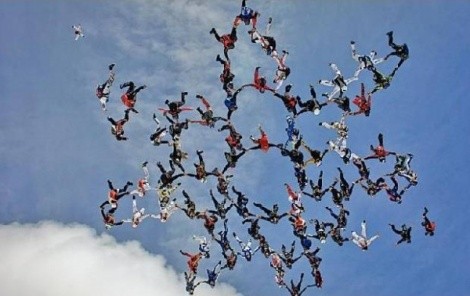
Dusty Hanks still gets tons of mileage out of the time a woman tipped him a $20 with her phone number on the bill. He is, after all, still teaching people how to jump out of planes. Not to mention he also married that woman five months later, and they now have two small children.
And if that little conversation piece doesn’t make a person lust for skydiving, how about this: Exiting an aircraft isn’t even required.
Hanks is a flight instructor at iFly Utah—an Ogden facility that is two years old, and one of about 10 such public wind tunnels in the country that simulate free fall. The nice thing about it, besides avoiding the old joke of jumping out of a perfectly good plane, is that it’s family-friendly. Going and doing the “real thing” locally in Tooele (Skydive Utah, Tooele Airport) or Ogden Skydiving Center (Hinckley Airport) means more advance planning and twice the expense.
There are perks of being brave enough to take the plane (spoken by someone who has done it): The unforgettable scent of plane fuel. The nearly unmatched queasiness that comes from equal parts nerves and adrenaline. The jaw-dropping macho/cool factor that comes at parties and reunions when describing the feeling. But the availability of an indoor facility also means that many of those same feelings can be had without much more hassle than driving.
The three facilities do some natural cross promotions, and Hanks said the biggest difference is that the tunnel is open to a broader range. “You have to be 18 to skydive,” he said, “but my 6-year-old son goes in the tunnel, and we’ve had people as old as 92 do it. It’s really the same feeling. And to be in the tunnel, it’s actually good practice for being outdoors because you have to be even more technically sound, because there’s less space. The only real big difference, obviously, is the view.”
Hanks, 33, recently found himself in illustrious skydiving company. Along with fellow Salt Lake City resident Gunnar Jeannette—they have more than 6,000 skydives between them—Hanks was part of a 108-member team that shattered a world record for a head-down formation. Auditioning alone took a couple of years around the country and a hit in the bank account, but it was worth it to be in Chicago on July 31.
They used five “Super Otter” planes to carry the 108 jumpers, complete with oxygen masks, to the altitude of 17,500 feet above terra firma. The jumpers had roughly 40 seconds to build the complete formation.
That was a unique thrill, but skydiving doesn’t have to be so time-consuming, record-breaking or exclusive to enjoy it. And an indoor facility is a great place to start.
Perhaps the butterflies don’t pile up as fast in the stomach, but the rest is basically the same. A 15-minute training seminar takes a newbie through hand signals, body position and how to enter and exit the tunnel. The clothing is also identical to outdoor gear.
“You’ll get taught how to experience ‘flight time,’” Hanks said. “That’s the awesome thing about it, and families can do it, or business groups. We’ve gotten a lot of business this year. It seems like people might not be taking as many vacations but they’re still looking for really cool things to do.”